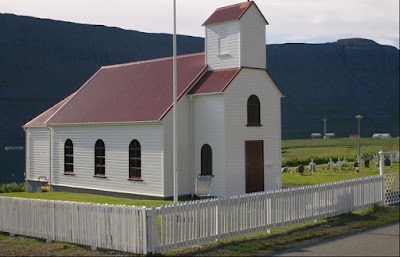Now heading for the the remotest area in Iceland: Westfiords (Vestfirðir), a large Arctic peninsula with a coastline heavily indented by dozens of fjords surrounded by steep hills. Communications by land are difficult, roads are extremely winding and most of the time ice-covered.
Súðavík lies in Álftafjörður, one of many fjords subsidiary to the Ísafjarðardjúp, a larger fjord, almost a gulf.
Súðavík is one of several similar fishing villages on Iceland's northwest coast, in Westfjords. A main street (Aðalgata) with some two- or three-storey wooden houses, some painted white, others blue, a few red; a tiny white wooden church; and a fishing harbour. Two things matter the most about Suðavik: it lies at 66° N, just under the Arctic Circle, and is surrounded by a glorious scenery:
Súðavík
Coordinates: 66° 01′ N, 22° 60′ W
Population: ~220
One of the old residents house during the 'Blueberry Festival'.
The village's main activities currently are fishing, fish processing and tourism.
There are summerhouses and guest agents operating in Súðavík, such as a sea angling company and a tour guide business.
Swanfjord Guesthouse
A modern holiday house in Túngata
The blue house of the Arctic Fox Centre, set in a magnificent scenery.
The highlight in town is the Arctic Fox Centre (Melrakkasetur), a museum and research centre devoted to the protection of the Arctic fox. It's housed in the oldest and best preserved wooden house in town.
Foxes are the only native mammal in Iceland. The Arctic Fox Centre was established in 2007, and is presently directed by Ester Rut Unnsteinsdóttir, one of the founders. The Environmental agency of Iceland is responsible for wildlife management.
A visiting school in Summer brings joviality to an usually gloomy place.
There is a nice café for the visitors' comfort.
At 66ºC, that really is luxury.
The Centre under Northern Lights
The church in Súðavík is a modest small wooden building from the 19th century.
The church was moved here from another location nearby in 1963.
------------------------------
Súðavík was sadly on the news in January 1995, when an avalanche fell on the village early in the morning and destroyed several buildings, most of them residents' houses. Fourteen people were killed and twelve were injured. Severe snow storms made the rescue work difficult and dangerous.
At a public meeting in 1995, it was decided that the village should be rebuilt at a safer location.
Over fifty new houses were built, the industries in the area were relocated with the exception of the freezing plant, which continues to operate.
New housing.
The Amma Habby, local restaurant and café.
But it's Nature that reigns here, almost unchallenged.
The recently built road tunnel under Northern Lights:





































6 comments:
After a few minutes of thinking about it, how DID the arctic fox get to Iceland? It presumably was formed through volcanicity, and was isolated for all of its life. Foxes don't swim that far, nor do they fly. HOW did they get on the island??
I suppose they got there during the last Ice Age, anyway before the Vikings arrived; there was surely a solid ice connection either to Scandinavia or Greenland.
Foxes aren't bears, they don't dive for fish.
They do dive into the snow, for lemmings.
Last comment, promise. Lemmings do have to eat something too. SOMETHING must eat grass for the food chain to exist. There is 0 grass, 0 food on a glacier over open ocean. The only food is underwater, being fish, which is how polar bears can live on floating ice. If there is no grass, there are no grass eaters, meaning no predators to eat them, meaning 0 food for the foxes.
Things do not add up.
From Wikipedia:
(Lemminga)are herbivorous, feeding mostly on mosses and grasses. They also forage through the snow surface to find berries, leaves, shoots, roots, bulbs, and lichens
Lemmings do not hibernate through the harsh northern winter. They remain active, finding food by burrowing through the snow. These rodents live in large tunnel systems beneath the snow in winter, which protect them from predators.
Post a Comment